Leukocytes Study guides, Class notes & Summaries
Looking for the best study guides, study notes and summaries about Leukocytes? On this page you'll find 6565 study documents about Leukocytes.
All 6.565 results
Sort by
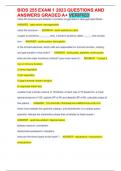 Popular
Popular
-
BIOS 255 EXAM 1 2023 QUESTIONS AND ANSWERS GRADED A+ VERIFIED
- Exam (elaborations) • 4 pages • 2023
-
- $15.99
- 10x sold
- + learn more
name the structure and whether it contains oxygenated or deoxygenated blood - ANSWER right atrium; deoxygenated name the structure - ANSWER aortic semilunar valve oxygen is carried by _______ cells. it binds to proteins called ______ that contain iron - ANSWER erythrocytes; hemoglobin of the formed elements, which cells are responsible for immune function, clotting, and gas transfer-in that order? - ANSWER leukocytes, platelets, erythrocytes what are the major functions of blood? (you ...
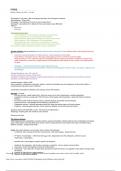 Popular
Popular
-
SCI 225 Pathophysiology - Nightingale College pathophysiology Midterm study guide.
- Summary • 7 pages • 2023 Popular
-
- $10.49
- 6x sold
- + learn more
notes Monday, February 20, 2023 9:19 AM Homozygous the same - BB= homozygous dominant; bb homozygous recessive Heterozygous different-Bb - Phenotype the expression of the trait (are the eyes blue?) Genotype exact pairing of the alleles( B =blue eyes b=green eyes) BB,bb,Bb Alleles • Recessive • Dominant Chromosomal disorders • Turner syndrome→ 45 chromosomes/ missing sex chromosomes. • cri-du - chat syndrome:→ 5 chromosomes has a deletion • Burkitt lymphoma- transloc...
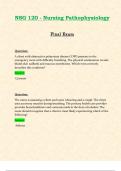
-
NSG120 / NSG 120 Final Exam (Latest 2024 / 2025 Update): Nursing Pathophysiology | Exam Review with Questions and Verified Answers | All Units Covered | 100% Correct | Grade A – Herzing
- Exam (elaborations) • 27 pages • 2024
- Available in package deal
-
- $8.49
- 5x sold
- + learn more
Final Exam: NSG120 / NSG 120 (Latest 2024 / 2025 Update) Nursing Pathophysiology Exam Review with Questions and Verified Answers | All Units Covered | 100% Correct | Grade A – Herzing Q: A client with obstructive pulmonary disease COPD presents to the emergency room with difficulty breathing. The physical examination reveals bluish skin nailbeds and mucous membranes. Which term correctly describes this condition? Answer: Cyanosis Q: The nurse is assessing a client and notes wheezing and a coug...
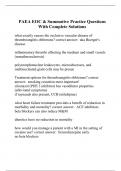
-
PAEA EOC & Summative Practice Questions With Complete Solutions
- Exam (elaborations) • 38 pages • 2023
-
Available in package deal
-
- $12.99
- 2x sold
- + learn more
what exactly causes the occlusive vascular disease of thromboangiitis obliterans? correct answer: aka Buerger's disease inflammatory thrombi affecting the medium and small vessels (nonatherosclerosis) polymorphonuclear leukocytes, microabscesses, and multinucleated giant cells may be presen Treatment options for thromboangiitis obliterans? correct answer: smoking cessation most important! cilostazol (PDE 3 inhibitor) has vasodilator properties (alleviated symptoms) if raynauds also...
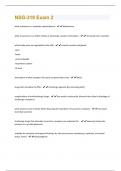
-
NSG-318 Exam 2 Questions and Answers Solved Correctly
- Exam (elaborations) • 28 pages • 2023
- Available in package deal
-
- $12.29
- 2x sold
- + learn more
what substance is a synthetic catecholamine - dobutamine what occurrence is an effect of beta-1 adrenergic receptor stimulation - increased renin secretion which body parts are regulated by the ANS - smooth muscles and glands -eyes -heart -urinary bladder -respiratory system -GI tract stimulation of what receptor will cause increased heart rate - Beta 1 drugs that stimulate the PNS - cholinergic agonists (by mimicking ACH) complications of anticholinergic drugs - dry mouth, tachycardia...
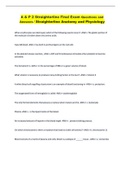
-
A & P 2 Straighterline Final Exam Questions and Answers / Straighterline Anatomy and Physiology
- Exam (elaborations) • 33 pages • 2023
- Available in package deal
-
- $10.99
- 21x sold
- + learn more
A & P 2 Straighterline Final Exam Questions and Answers / Straighterline Anatomy and Physiology When erythrocytes are destroyed, which of the following events occurs? -ANS>> The globin portion of the molecule is broken down into amino acids. Type AB blood -ANS>> has both A and B antigens on the red cells In the platelet release reaction, -ANS>> ADP and thromboxanes stimulate other platelets to become activated. The hematocrit is -ANS>> d. the percentage of RBC...

-
NRNP 6568 Final Exam Questions with 100% Correct Answers Latest 2023/2024 (Graded)
- Exam (elaborations) • 15 pages • 2023
- Available in package deal
-
- $17.99
- 4x sold
- + learn more
NRNP 6568 Final Exam Questions with 100% Correct Answers Latest 2023/2024 (Graded). Diabetes mellitus causes both microvascular and macrovascular damage. All of the following are indications of microvascular damage except: Selected Answer: Atherosclerosis Answers: Retinopathy Nephropathy Neuropathy Atherosclerosis Question 7 1 out of 1 points Hemoglobin A1C is the average glucose level of what length of time? Selected Answer: 3 months Answers: 1 month 2 months 3 months 4 mo...

-
113 Leukocytes Exam Review Solution A+ 2024
- Exam (elaborations) • 5 pages • 2024
-
- $10.49
- + learn more
113 Leukocytes Exam Review Solution A+ 2024 the five types of leukocytes - ANS-- neutrophils - basophils - eosinophils - monocytes - lymphocytes the three R's (responsibilities of leukocytes) - ANS-responsible for RECOGNITION, RESPONSE, and REMOVAL of foreign material ("non-self") and damaged or dead cells and tissues from the body leukocytes - ANS-- lifespans of leukocytes vary from hours to years depending on the type of cell - each type of leukocyte has a specific job - ...
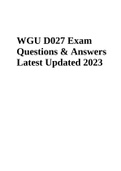
-
WGU D027 Exam Questions & Answers Latest Updated 2023
- Exam (elaborations) • 19 pages • 2023
-
- $18.49
- 9x sold
- + learn more
WGU D027 Exam Questions & Answers Latest Updated 2023. What syndrome, characterized by an absent homologous X chromosome with only a single X chromosome, exhibits features that include a short stature, total chromosome count of 45, webbed neck, and a shield like chest? (0/1 Point) Cri du chat syndrome Down syndrome Klinefelter syndrome Turner syndrome 3.A female patient has been recently diagnosed with invasive ductal carcinoma. As an advanced practice nurse, you understand that she wil...
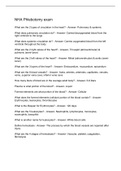
-
NHA Phlebotomy Exam 2023
- Exam (elaborations) • 8 pages • 2023
-
Available in package deal
-
- $9.99
- 4x sold
- + learn more
What are the 2 types of circulation in the heart? - Answer- Pulmonary & systemic What does pulmonary circulation do? - Answer- Carried deoxygenated blood from the right ventricle to the lungs What does systemic circulation do? - Answer- Carries oxygenated blood from the left ventricle throughout the body What are the 2 right valves of the heart? - Answer- Tricuspid (atrioventricular) & pulmonic (semi-lunar) What are the 2 left valves of the heart? - Answer- Mitral (atrioventricular) ...

Do you wonder why so many students wear nice clothes, have money to spare and enjoy tons of free time? Well, they sell on Stuvia! Imagine your study notes being downloaded a dozen times for $15 each. Every. Single. Day. Discover all about earning on Stuvia


